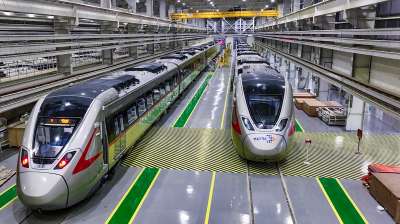PM launches India’s first Regional Rapid Transit System (RRTS) called NaMo Bharat train
The Regional Rapid Transit System (RRTS) is a new, high-speed, high-capacity commuter service that connects regional nodes in the National Capital Region (NCR). The RRTS is different from conventional railways because it provides reliable, high-frequency, point-to-point regional travel at high speed along a dedicated path.
The RRTS aims to promote balanced and sustainable urban development by enhancing connectivity and accessibility across the NCR. It is supposed to serve the region around Delhi and enhance inter-state connectivity.
The Namo Bharat train was launched on Sahibabad-Duhai strech of Delhi-Ghaziabad-Meerut RRTS Corridor.
RRTS is a new rail-based, semi-high-speed, high-frequency commuter transit system with a design speed of 180 Kmph for better connectivity across NCR.

RRTS was proposed by National Capital Region Planning Board.
♦ The board had identified 8 RRTS corridors in its “Functional Plan on Transport for NCR – 2032”.
National Capital Region Transport Corporation (NCRTC) is mandated to implement RRTS.
♦ NCRTC under Ministry of Housing and Urban Affairs is a joint venture company of Government of India and
States of Delhi, Haryana, Rajasthan and U.P.
In line with PM GatiShakti National Master Plan, RRTS network will have extensive multi-modal integration with Railway stations, Metro stations, Bus services etc.
Advantages of RRTS
- Promote balanced sustainable growth in NCR.
- Travel time reduction by 60-75%.
- Decongesting traffic and reduction in pollution (majority of energy requirement will be met through renewable sources).
- Unlike metro RRTS covers relatively longer distance with fewer stops.
- Unlike conventional Railways, RRTS will provide reliable, high frequency, point to point regional travel along dedicated path way.
